.
Tehran, Iran. A child looks on as Iranian mourners attend the funeral of Mohammad Hamidi, Hasan Ghafari and Ali Amrai, all three members of the Islamic Republic’s Revolutionary Guards reportedly killed in Syria fighting against the Islamic State jihadis: photo by Atta Kenare/AFP, 25 June 2015
A statue depicting US’ Statue of Liberty decorated with a Star of
David on its head is set ablaze by Iranian protestors during a parade
marking al-Quds (Jerusalem) Day in Tehran: photo by Atta Kenare/AFP, 1 July 2016
A statue depicting US’ Statue of Liberty decorated with a Star of
David on its head is set ablaze by Iranian protestors during a parade
marking al-Quds (Jerusalem) Day in Tehran: photo by Atta Kenare/AFP, 1 July 2016

IRAN - A man walks along a street past a mosaic mural on the first anniversary of the nuclear agreement in Tehran. By Atta Kenare #AFP: image via Frédérique Geffard @fgeffardAFP, 15 January 2017

#India An Indian worker sorts out plastic bottles at a warehouse in Jalandhar. #AFP Photo @shammiphotos: image via AFP Photo @AFPphoto, 7 May 2018
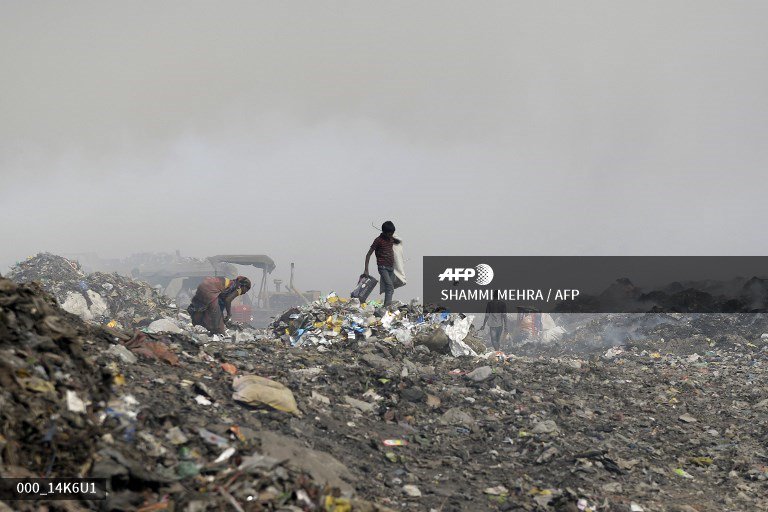
#India Indian rag pickers work in a landfill site full of plastic bags on the outskirts of Jalandhar. #AFP Photo @shammiphotos: image via AFP Photo @AFPphoto, 7 May 2018

#India Indian rag pickers work in a landfill site full of plastic bags on the outskirts of Jalandhar. #AFP Photo @shammiphotos: image via AFP Photo @AFPphoto, 7 May 2018
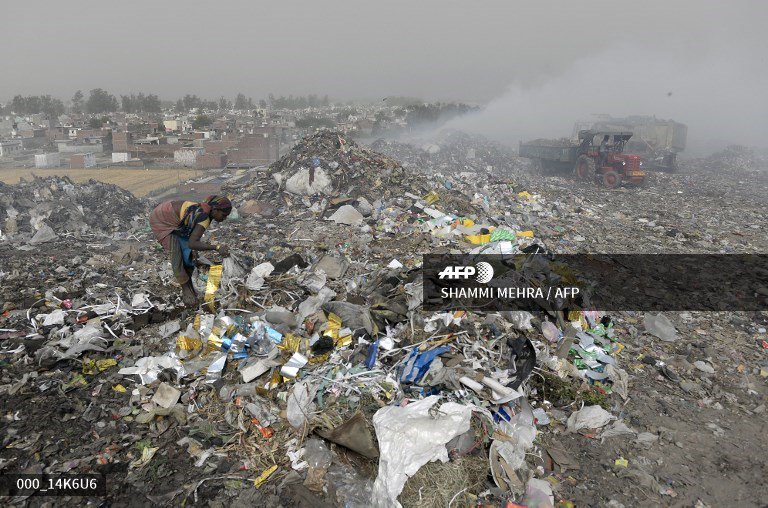
#India Indian rag pickers work in a landfill site full of plastic bags on the outskirts of Jalandhar. #AFP Photo @shammiphotos: image via AFP Photo @AFPphoto, 7 May 2018

#India Indian rag pickers work in a landfill site full of plastic bags on the outskirts of Jalandhar. #AFP Photo @shammiphotos: image via AFP Photo @AFPphoto, 7 May 2018

#Sierra Leone Residents of Freetown take part in the first edition of the "National Cleaning Day". The first Saturday of each month citizen of Sierra Leone are called to engage in cleaning their streets. Photo @MohamedsaiduBah #AFP: image via Frédérique Geffard @fgeffardAFP, 5 May 2018

#India Indian rag pickers work in a landfill site full of plastic bags on the outskirts of Jalandhar. #AFP Photo @shammiphotos: image via AFP Photo @AFPphoto, 7 May 2018

#India Indian rag pickers work in a landfill site full of plastic bags on the outskirts of Jalandhar. #AFP Photo @shammiphotos: image via AFP Photo @AFPphoto, 7 May 2018

#India Indian rag pickers work in a landfill site full of plastic bags on the outskirts of Jalandhar. #AFP Photo @shammiphotos: image via AFP Photo @AFPphoto, 7 May 2018

#India Indian rag pickers work in a landfill site full of plastic bags on the outskirts of Jalandhar. #AFP Photo @shammiphotos: image via AFP Photo @AFPphoto, 7 May 2018

#Sierra Leone Residents of Freetown take part in the first edition of the "National Cleaning Day". The first Saturday of each month citizen of Sierra Leone are called to engage in cleaning their streets. Photo @MohamedsaiduBah #AFP: image via Frédérique Geffard @fgeffardAFP, 5 May 2018
This way to yet another Dirty War
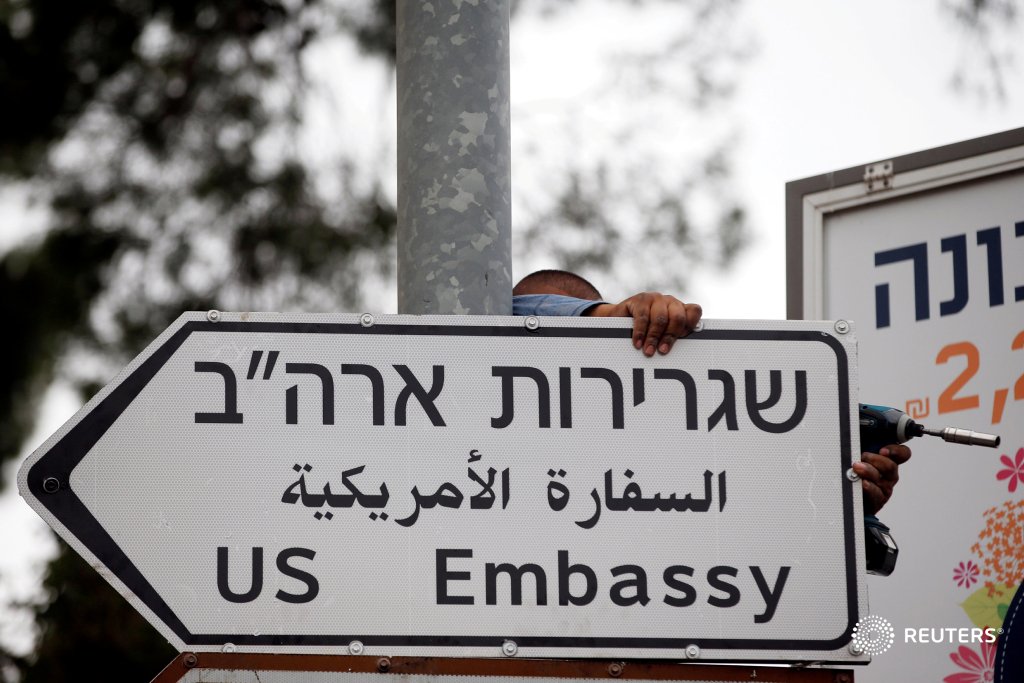
U.S. Embassy road signs go up in Jerusalem: image via Reuters Pictures @reuterspictures, 7 May 2018
Israeli Prime Minister Benjamin Netanyahu’s claim in his theatrical 20-minute presentation of an Israeli physical seizure of Iran’s “atomic archive” in Tehran would certainly have been the “great intelligence achievement” he boasted if it had actually happened. But the claim does not hold up under careful scrutiny, and his assertion that Israel now possesses a vast documentary record of a covert Iranian nuclear weapons program is certainly fraudulent.
Netanyahu’s tale of an Israeli intelligence raid right in Tehran that carted off 55,000 paper files and another 55,000 CDs from a “highly secret location” requires that we accept a proposition that is absurd on its face: that Iranian policymakers decided to store their most sensitive military secrets in a small tin-roofed hut with nothing to protect it from heat (thus almost certainly ensuring loss of data on CDs within a few years) and no sign of any security, based on the satellite image shown in the slide show. (As Steve Simon observed in The New York Times the door did not even appear to have a lock on it.)
The laughable explanation suggested by Israeli officials to The Daily Telegraph– that the Iranian government was afraid the files might be found by international inspectors if they remained at “major bases” — merely reveals the utter contempt that Netanyahu has for Western governments and news media. Even if Iran were pursuing nuclear weapons secretly, their files on the subject would be kept at the Ministry of Defense, not at military bases. And of course the alleged but wholly implausible move to an implausible new location came just as Netanyahu needed a dramatic new story to galvanize Trump to resist the European allies’ strong insistence on preserving the Joint Comprehensive Plan of Act (JCPOA) nuclear deal with Iran.
In fact, there is no massive treasure trove of secret files about an Iran “Manhattan Project.” The shelves of black binders and CDs that Netanyahu revealed with such a dramatic flourish date back to 2003 (after which a U.S. National Intelligence Estimate (NIE) said Iran had abandoned any nuclear weapons program) and became nothing more than stage props like the cartoon bomb that Netanyahu used at the United Nations in 2012.
Disinformation Campaign
Netanyahu’s claim about how Israel acquired this “atomic archive” is only the latest manifestation of a long-term disinformation campaign that the Israeli government began to work on in 2002-03. The documents to which Netanyahu referred in the presentation were introduced to the news media and the International Atomic Energy Agency (IAEA) beginning in 2005 as coming originally from a secret Iranian nuclear weapons research program. For many years U.S. news media have accepted those documents as authentic. But despite the solid media united front behind that narrative, we now know with certainty that those earlier documents were fabrications and that they were created by Israel’s Mossad.
That evidence of fraud begins with the alleged origins of the entire collection of documents. Senior intelligence officials in the George W. Bush administration had told reporters that the documents came from “a stolen Iranian laptop computer”, as The New York Times reported in November 2005. The Times quoted unnamed intelligence officials as insisting that the documents had not come from an Iranian resistance group, which would cast serious doubt on their reliability.
But it turned that the assurances from those intelligence officials were part of an official dissimulation. The first reliable account of the documents’ path to the United States came only in 2013, when former senior German foreign office official Karsten Voigt, who retired from his long-time position as coordinator of German-North American cooperation, spoke with this writer on the record.
Voigt recalled how senior officials of the German foreign intelligence agency, the Bundesnachtendeinst or BND, had explained to him in November 2004 that they were familiar with the documents on the alleged Iran nuclear weapons program, because a sometime source—but not an actual intelligence agent—had provided them earlier that year. Furthermore, the BND officials explained that they had viewed the source as “doubtful,” he recalled, because the source had belonged to the Mujahideen-E Khalq, the armed Iranian opposition group that had fought Iran on behalf of Iraq during the eight year war.
BND officials were concerned that the Bush administration had begun citing those documents as evidence against Iran, because of their experience with “Curveball” – the Iraqi engineer in Germany who had told stories of Iraqi mobile bioweapons labs that had turned to be false. As a result of that meeting with BND officials, Voigt had given an interview to The Wall Street Journalin which he had contradicted the assurance of the unnamed U.S. intelligence officials to the Times and warned that the Bush administration should not base its policy on the documents it was beginning to cite as evidence of an Iranian nuclear weapons program, because they had indeed come from “an Iranian dissident group.”
Using the MEK
The Bush administration’s desire to steer press coverage of the supposedly internal Iranian documents away from the MEK is understandable: the truth about the MEK role would immediately lead to Israel, because it was well known, that Israel’s intelligence agency Mossad had used the MEK to make public information that the Israelis did not want attributed to itself – including the precise location of Iran’s Natanz enrichment facility. As Israeli journalists Yossi Melman and Meir Javadanfar observed in their 2007 book on the Iran nuclear program, based on U.S., British and Israeli officials, “Information is ‘filtered’ to the IAEA via Iranian opposition groups, especially the National Resistance Council of Iran.”
Mossad used the MEK repeatedly in the 1990s and the early 2000’s to get the IAEA to inspect any site the Israelis suspected might possibly be nuclear-related, earning their Iranian clients a very poor reputation at the IAEA. No one familiar with the record of the MEK could have believed that it was capable of creating the detailed documents that were passed to the German government. That required an organization with the expertise in nuclear weapons and experience in fabricating documents – both of which Israel’s Mossad had in abundance.
El Baradei: Didn’t buy it.
Bush administration officials had highlighted a set of 18 schematic drawings of the Shahab-3 missile’s reentry vehicle or nosecone of the missile in each of which there was a round shape representing a nuclear weapon. Those drawings were described to foreign governments and the International Atomic Energy Agency as 18 different attempts to integrate a nuclear weapon into the Shahab-3.
Netanyahu gave the public its first glimpse of one of those drawings Monday when he pointed to it triumphantly as visually striking evidence of Iranian nuclear perfidy. But that schematic drawing had a fundamental flaw that proved that it and others in the set could not have been genuine: it showed the “dunce cap” shaped reentry vehicle design of the original Shahab-3 missile that had been tested from 1998 to 2000. That was the shape that intelligence analysts outside Iran had assumed in 2002 and 2003 Iran would continue to use in its ballistic missile.
New Nose Cone
It is now well established, however, that Iran had begun redesigning the Shahab-3 missile with a conical reentry vehicle or nosecone as early as 2000 and replaced it with a completely different design that had a “triconic” or “baby bottle” shape. It made it a missile with very different flight capabilities and was ultimately called the Ghadr-1. Michael Elleman, the world’s leading expert on Iranian ballistic missiles, documented the redesign of the missile in his path-breaking 2010 study of Iran’s missile program.
Iran kept its newly-designed missile with the baby bottle reentry vehicle secret from the outside world until its first test in mid-2004. Elleman concluded that Iran was deliberately misleading the rest of the world – and especially the Israelis, who represented the most immediate threat of attack on Iran – to believe that the old model was the missile of the future while already shifting its planning to the new design, which would bring all of Israel within reach for the first time.
The authors of the drawings that Netanyahu displayed on the screen were thus in the dark about the change in the Iranian design. The earliest date of a document on the redesign of the reentry vehicle in the collection obtained by U.S. intelligence was August 28, 2002 – about two years after the actual redesign had begun. That major error indicates unmistakably that the schematic drawings showing a nuclear weapon in a Shahab-3 reentry vehicle – what Netanyahu called “integrated warhead design” were fabrications.
Netanyahu’s slide show highlighted a series of alleged revelations that he said came from the newly acquired “atomic archive” concerning the so-called “Amad Plan” and the continuation of the activities of the Iranian who was said to have led that covert nuclear weapons project. But the single pages of Farsi language documents he flashed on the screen were also clearly from the same cache of documents that we now know came from the MEK-Israeli combination. Those documents were never authenticated, and IAEA Director-General Mohamed ElBaradei, who was skeptical of their authenticity, had insisted that without such authentication, he could not accuse Iran of having a nuclear weapons program.
Shahab 3: Secretly got a new nose cone.: photo Atta Kennare / AFP
There are other indications of fraud in that collection of documents as well. A second element of the supposed covert arms plan given the name "Amad Plan" was a "process flow chart" of a bench-scale system for converting uranium ore for enrichment. It had the code name "Project 13", according to a briefing by the IAEA Deputy Director Olli Heinonen, and was part of the larger so-called "Project 5", according to an official IAEA report. Another sub-project under that rubric was "Project 5.15", which involved processing at the Gchine Mine. Both projects were said to be carried out by a consulting form named Kimia Maadan.
But documents that Iran later provided to the IAEA proved that, in fact, “Project 5.15” did exist, but was a civilian project of the Atomic Energy Organization of Iran, not part of a covert nuclear weapons program, and that the decision had been made in August 1999 – two years before the beginning of the alleged “Amad Plan” was said to have begun.
The role of Kimia Maadan in both sub-projects explains why an ore processing project would be included in the supposed secret nuclear weapons program. One of the very few documents included in the cache that could actually be verified as authentic was a letter from Kimia Maadan on another subject, which suggests that the authors of the documents were building the collection around a few documents that could be authenticated.
Netanyahu also lingered over Iran’s denial that it had done any work on “MPI” or (“Multi-Point Initiation”) technology “in hemispheric geometry”. He asserted that “the files” showed Iran had done “extensive work” or “MPI” experiments. He did not elaborate on the point. But Israel did not discover the alleged evidence of such experiments in a tin-roofed shack in Tehran. The issue of whether Iran had done such experiments was a central issue in the IAEA’s inquiry after 2008. The agency described it in a September 2008 report, which purported to be about Iran’s “experimentation in connection with symmetrical initiation of a hemispherical high explosive charge suitable for an implosion type nuclear device.”
No Official Seals
The IAEA refused to reveal which member country had provided the document to the IAEA. But former Director-General ElBaradei revealed in his memoirs that Israel had passed a series of documents to the Agency in order to establish the case that Iran had continued its nuclear weapons experiments until “at least 2007.” ElBaradei was referring to convenient timing of the report’s appearance within a few months of the U.S. NIE of November 2007 concluding that Iran had ended its nuclear weapons-related research in 2003.
Netanyahu pointed to a series of documents on the screen as well a number of drawings, photographs and technical figures, and even a grainy old black and white film, as evidence of Iran’s nuclear weapons work. But absolutely nothing about them provides an evidentiary link to the Iranian government. As Tariq Rauf, who was head of the IAEA’s Verification and Security Policy Coordination Office from 2002 to 2012, noted in an e-mail, none of the pages of text on the screen show official seals or marks that would identify them as actual Iranian government documents. The purported Iranian documents given to the IAEA in 2005 similarly lacked such official markings, as an IAEA official conceded to me in 2008.
Netanyahu’s slide show revealed more than just his over-the-top style of persuasion on the subject of Iran. It provided further evidence that the claims that had successfully swayed the U.S. and Israeli allies to join in punishing Iran for having had a nuclear weapons program were based on fabricated documents that originated in the state that had the strongest motive to make that case – Israel.
Gareth Porter is an independent investigative journalist and historian on U.S. national security policy and the recipient of the 2012 Gellhorn Prize for journalism. His most recent book is Manufactured Crisis: the Untold Story of the Iran Nuclear Scare, published in 2014.
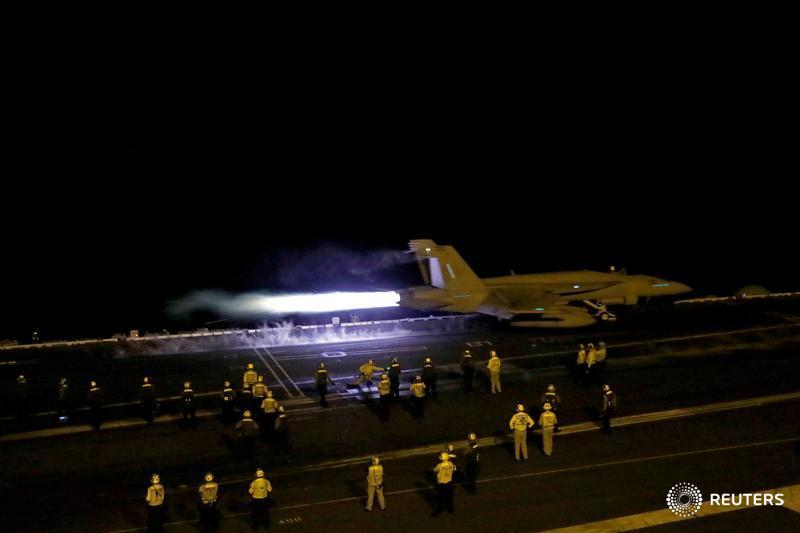
A U.S. naval strike force takes off from the aircraft carrier USS Harry S. Truman for missions against Islamic State in Syria Photo @alkskon: image via Reuters Pictures @reuterspictures, 7 May 2018

SYRIA - Children sleep on a bus in Yalda on the outskirts of Damascus, as fighters and civilians from the areas of Yalda, Babila and Beit Sahem are evacuated to rebel-held area in northwestern Syria Photo
Rami al Sayed #AFP: image via Frédérique Geffard @fgeffardAFP, 6 May 2018
Netanyahu and his defence minister given the unilateral power to take Israel to war: Previously, Israeli leaders had to seek the approval of the full Cabinet to go to war or even to embark on a military action: Isabel Kershner, The New York Times, 3 May 2018
Israeli Prime Minister and Comedian Benjamin Netanyahu harps on the latest fifth-hand fabricated details about Iranian nuclear weapons development during a theatrical presentation masquerading as a press conference in Tel Aviv on April 30 2018.: photo by
JERUSALEM — As Israel faces rising tensions with Iran, Syria and Gaza, its Parliament passed a new law allowing the prime minister and defense minister to decide alone whether their nation will go to war.
The legislation, which comes after multiple attacks inside Syria widely believed to have been carried out by Israel, makes it much easier for Prime Minister Benjamin Netanyahu to declare war. Although the new law restricts the use of that power to “extreme circumstances,” it has provoked domestic criticism for concentrating it in the hands of just two people.
The law is “nothing less than insane,” said Ofer
Shelah, a legislator from the centrist Yesh Atid party, which sits in
opposition. “I am deluged with calls from experienced security officials
who are shocked, and rightfully so,” he wrote on Twitter.
The measure, an amendment to the Basic Laws that serve as Israel’s constitution, passed Monday night by a vote of 62-41 in the 120-seat Knesset. The vote was initially overshadowed by Netanyahu’s dramatic, televised news conference the same night in which he presented evidence that he said proved that Iran had been lying about its efforts to build a nuclear weapon.

The presentation, based on a cache of stolen Iranian
documents, capped a long campaign by Netanyahu to kill the international
agreement to curb Iran’s nuclear program. President Donald Trump faces a
May 12 deadline to decide whether to pull the United States out of the
agreement.
And it comes amid an escalating shadow war with Iran.
Airstrikes on a suspected missile storage site near Hama, Syria, on Sunday which destroyed a cache of missiles and killed at least 16 people, many of them Iranians, were reported to have been carried out by Israel. Israel is believed to have conducted several previous attacks in Syria on assets belonging to Iran and its allies, and is bracing for promised Iranian retaliation for a strike on an air base in Syria last month.
The new law would not necessarily change the procedure for those airstrikes, which Israel has not acknowledged. What approval may be required for these strikes is not public information.
But it could give Netanyahu more latitude to broaden the hostilities into open warfare.

The law was not written with the current skirmishes with
Iran in mind, according to one of the architects of the reform, and
applies to any prime minister and defense minister, not just the current
ones.
Still, critics note that Netanyahu is under investigation in multiple corruption cases and is fighting for his political future, and the current defense minister, Avigdor Lieberman, is a political hard-liner with little security experience. Those issues could raise questions about their motivations should they decide to take Israel to war.
The law reduces the approval required to go to war from the full Cabinet to half of the much smaller security Cabinet under most circumstances. But a provision was added late in the process to give that authority to the prime minister and defense minister in “extreme circumstances.”
“The last-minute addition giving authority under extreme circumstances to the prime minister and defense minister on their own appears to be out of order,” said Yehuda Ben Meir, head of the national security and public opinion project at the Institute for National Security Studies at Tel Aviv University. “It is not appropriate to Israel’s constitutional system of government.”
The law does not define what constitutes “extreme circumstances.”
Previously, Israeli leaders had to seek the approval of the full Cabinet to go to war, or even to embark on a military action that was likely to lead to war. But in recent years, governments have swelled to up to 30 ministers. Advocates of the new law say that with the larger Cabinets, that system has become unwieldy.
However, some experts also said that the law may have little practical effect since the prime minister and defense minister were unlikely to go to war without strong political backing and the support of the military and security agencies, which have proved in the past to be cautious.
“A government cannot go to war, no matter what the law says, without a national consensus,” said Shlomo Avineri, professor emeritus of political science at the Hebrew University of Jerusalem.
That Netanyahu’s motives could come under suspicion because of his legal troubles only strengthens the need for public and political support, Avineri said.
“Obviously a prime minister under investigation is limited by the kind of choices he can take, and they will be scrutinized even more than usual,” Avineri said, adding that in such a case, “the necessity for broad support is even wider.”
Several analysts pointed to an episode in 2010 when Netanyahu and his defense minister at the time, Ehud Barak, were eager to strike Iran’s nuclear facilities but were stopped from doing so by the Israeli military, which said it lacked the ability, and by the opposition of the broader security establishment.
While that example suggests that Israeli leaders would not go to war without broader support, the following year, Netanyahu and Barak wanted to strike Iran again and were stopped when two ministers balked at the idea, Barak later said.
Under the new law, they may have had a freer hand to attack Iran.
A committee was established in 2016 to formulate recommendations to improve the workings of the Cabinet. Headed by Yaakov Amidror, a former Israeli national security adviser and a major general in the reserves, the committee recommended giving the authority to go to war to the more select political-security Cabinet, which by law numbers at least seven members and not more than half the members of the government.
Amidror said in an interview that Netanyahu was “happy with our recommendation,” but that the newly amended law went beyond that. Netanyahu argued that the law’s requirement of a quorum of the security Cabinet could lead to paralysis in an emergency, Amidror said.
He said that only then did Netanyahu push for the power to be vested in the prime minister and defense minister.
Amidror insisted that the timing of the new law was coincidental and had nothing to do with the current tensions.
“I was behind it so I know for sure there is no connection,” he said. “In Israel, any timing is bad timing.”
The measure, an amendment to the Basic Laws that serve as Israel’s constitution, passed Monday night by a vote of 62-41 in the 120-seat Knesset. The vote was initially overshadowed by Netanyahu’s dramatic, televised news conference the same night in which he presented evidence that he said proved that Iran had been lying about its efforts to build a nuclear weapon.
This photo released by the Israel Defence Forces shows what was believed by those dupes who take as solid gilded truth every word that flops out of the Beebster's mouth and wriggles on the pier a bit, begging to be put out of its misery, to be a nuclear reactor site that was destroyed by Israel, in the Deir
el-Zour region, 450 kilometres northwest of Damascus, Syria.: image by
And it comes amid an escalating shadow war with Iran.
Airstrikes on a suspected missile storage site near Hama, Syria, on Sunday which destroyed a cache of missiles and killed at least 16 people, many of them Iranians, were reported to have been carried out by Israel. Israel is believed to have conducted several previous attacks in Syria on assets belonging to Iran and its allies, and is bracing for promised Iranian retaliation for a strike on an air base in Syria last month.
The new law would not necessarily change the procedure for those airstrikes, which Israel has not acknowledged. What approval may be required for these strikes is not public information.
But it could give Netanyahu more latitude to broaden the hostilities into open warfare.

Latest
appointee to President Donald #Trump's legal team Rudy Giuliani attends
the Iran Freedom Convention for Democracy and Human Rights Photo:
Tasos Katopidis: James D. Morgan: image via Getty Images News @GettyImagesNews, 5 May 2018
Still, critics note that Netanyahu is under investigation in multiple corruption cases and is fighting for his political future, and the current defense minister, Avigdor Lieberman, is a political hard-liner with little security experience. Those issues could raise questions about their motivations should they decide to take Israel to war.
The law reduces the approval required to go to war from the full Cabinet to half of the much smaller security Cabinet under most circumstances. But a provision was added late in the process to give that authority to the prime minister and defense minister in “extreme circumstances.”
“The last-minute addition giving authority under extreme circumstances to the prime minister and defense minister on their own appears to be out of order,” said Yehuda Ben Meir, head of the national security and public opinion project at the Institute for National Security Studies at Tel Aviv University. “It is not appropriate to Israel’s constitutional system of government.”
The law does not define what constitutes “extreme circumstances.”
Previously, Israeli leaders had to seek the approval of the full Cabinet to go to war, or even to embark on a military action that was likely to lead to war. But in recent years, governments have swelled to up to 30 ministers. Advocates of the new law say that with the larger Cabinets, that system has become unwieldy.
However, some experts also said that the law may have little practical effect since the prime minister and defense minister were unlikely to go to war without strong political backing and the support of the military and security agencies, which have proved in the past to be cautious.
“A government cannot go to war, no matter what the law says, without a national consensus,” said Shlomo Avineri, professor emeritus of political science at the Hebrew University of Jerusalem.
That Netanyahu’s motives could come under suspicion because of his legal troubles only strengthens the need for public and political support, Avineri said.
“Obviously a prime minister under investigation is limited by the kind of choices he can take, and they will be scrutinized even more than usual,” Avineri said, adding that in such a case, “the necessity for broad support is even wider.”
Several analysts pointed to an episode in 2010 when Netanyahu and his defense minister at the time, Ehud Barak, were eager to strike Iran’s nuclear facilities but were stopped from doing so by the Israeli military, which said it lacked the ability, and by the opposition of the broader security establishment.
While that example suggests that Israeli leaders would not go to war without broader support, the following year, Netanyahu and Barak wanted to strike Iran again and were stopped when two ministers balked at the idea, Barak later said.
Under the new law, they may have had a freer hand to attack Iran.
A committee was established in 2016 to formulate recommendations to improve the workings of the Cabinet. Headed by Yaakov Amidror, a former Israeli national security adviser and a major general in the reserves, the committee recommended giving the authority to go to war to the more select political-security Cabinet, which by law numbers at least seven members and not more than half the members of the government.
Amidror said in an interview that Netanyahu was “happy with our recommendation,” but that the newly amended law went beyond that. Netanyahu argued that the law’s requirement of a quorum of the security Cabinet could lead to paralysis in an emergency, Amidror said.
He said that only then did Netanyahu push for the power to be vested in the prime minister and defense minister.
Amidror insisted that the timing of the new law was coincidental and had nothing to do with the current tensions.
“I was behind it so I know for sure there is no connection,” he said. “In Israel, any timing is bad timing.”
Russian Prime Minister Vladimir Putin, left, speaks with Avigdor Lieberman, then the Israeli Foreign Minister, at Putin’s Novo-Ogaryovo residence outside Moscow, on December 7, 2011.: photo by Alexey Druzhinin/
#Russia A pigeon walks in front as Russian servicemen standing guard at Red Square during the general rehearsal of the Victory Day military parade in Moscow Photo Kirill Kudryavtsev #AFP: image via Frédérique Geffard @fgeffardAFP, 6 May 2018

#Russia Russian soldiers attend the Victory Day military parade night rehearsal in Moscow. Photo Kirill Kudryavtsev #AFP: image via Frédérique Geffard @fgeffardAFP, 5 May 2018
A woman shades herself with an umbrella next to a group of Ultra-Orthodox Jewish men as they wait for transportation at a bus stop in Bnei Brak, Israel: photo by Oded Balilty/AP, 11 July 2016
A woman shades herself with an umbrella next to a group of Ultra-Orthodox Jewish men as they wait for transportation at a bus stop in Bnei Brak, Israel: photo by Oded Balilty/AP, 11 July 2016
Ultra-Orthodox Jews check palm fronds to determine if they are ritually acceptable as one of the four items used as a symbol on the Jewish holiday of Sukkot in Jerusalem, Thursday: photo by Oded Balilty/AP, 24 September 2015

An Iranian man performs Eid al-Adha prayers at Tehran University on September 24, 2015. Eid al-Adha (the Festival of Sacrifice) is celebrated throughout the Muslim world as a commemoration of Abraham’s willingness to sacrifice his son for God, and cows, camels, goats and sheep are traditionally slaughtered on the holiest day: photo by Atta Kenare/AFP, 24 September 2015
An Iranian man performs Eid al-Adha prayers at Tehran University on September 24, 2015. Eid al-Adha (the Festival of Sacrifice) is celebrated throughout the Muslim world as a commemoration of Abraham’s willingness to sacrifice his son for God, and cows, camels, goats and sheep are traditionally slaughtered on the holiest day: photo by Atta Kenare/AFP, 24 September 2015
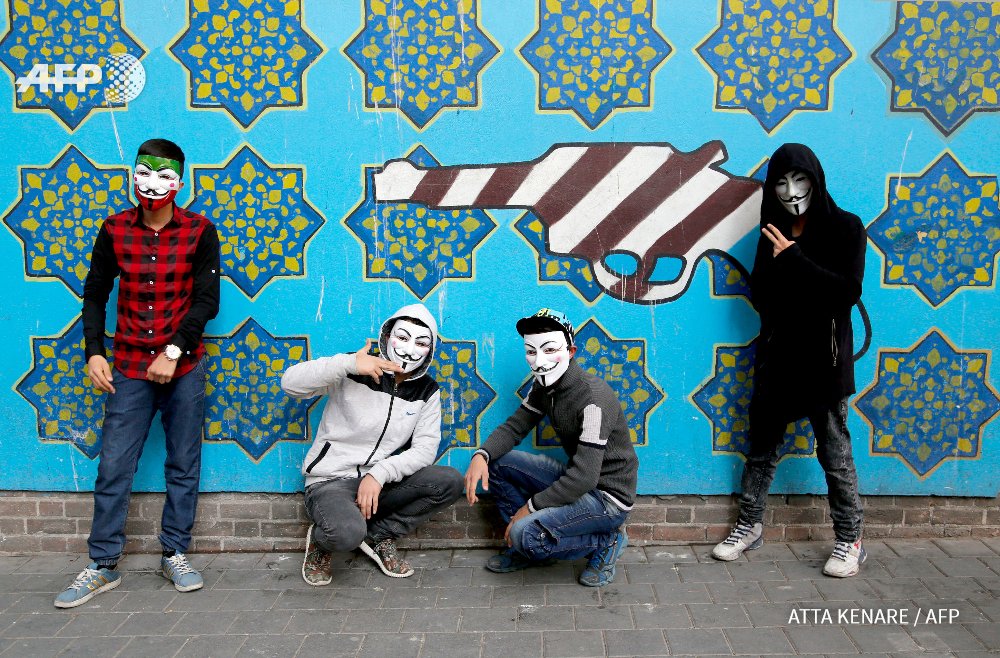
IRAN - Demonstration marking the anniversary of its storming by student protesters that triggered a hostage crisis in 1979. By Atta Kenare: image via Frédérique Geffard @geffardAFP, 3 November 2016
Iranians gather around a hearse carrying the coffin of former president Akbar Hashemi Rafsanjani during his funeral ceremony in the capital Tehran today: photo by Atta Kenare/AFP, 10 January 2017
Iranians gather around a hearse carrying the coffin of former president Akbar Hashemi Rafsanjani during his funeral ceremony in the capital Tehran today: photo by Atta Kenare/AFP, 10 January 2017
Iranian school girls attend a parliament session in Tehran: photo by Atta Kenare/AFP, 1 March 2016
Iranian school girls attend a parliament session in Tehran: photo by Atta Kenare/AFP, 1 March 2016
Haka Te Titi Haka Power-Fuschia o Conga Killary-Consortium Te Tikitaka!!
During a visit to #Auckland, @HillaryClinton poses with the #Maori performing group Te Kapa Haka o Whangara Mai Tawhiti Photo: James D. Morgan: image via Getty Images News @GettyImagesNews, 7 May 2018

GAZA STRIP - A young Palestinian peddlar sells boiled lupine seeds on a cart while wearing a plastic Feta cheese container for protection near a demonstration east of Jabalia Photo @mohmdabed #AFP: image via Frédérique Geffard @fgeffardAFP, 6 May 2018

#Sri Lanka Sri Lankan fishermen pull in a fishing net on a beach in Trincomalee Photo Ishara S Kodikara #AFP: image via Frédérique Geffard @fgeffardAFP, 6 May 2018

Sunset from Gaza sea, 4 May 2018, by: Hosam Salem #dailylife #streetphotography #Summer! image via HosamSalem @HosamSalemG, 4 May 2018
Forugh Farrokhzad: The Wind Will
Take Us
In my small night, ah
the wind has a date with the leaves of the trees
in my small night there is agony of destruction
listen
do you hear the darkness blowing?
I look upon this bliss as a stranger
I am addicted to my despair.
listen do you hear the darkness blowing?
something is passing in the night
the moon is restless and red
and over this rooftop
where crumbling is a constant fear
clouds, like a procession of mourners
seem to be waiting for the moment of rain.
a moment
and then nothing
night shudders beyond this window
and the earth winds to a halt
beyond this window
something unknown is watching you and me.
O green from head to foot
place your hands like a burning memory
in my loving hands
give your lips to the caresses
of my loving lips
like the warm perception of being
the wind will take us
the wind will take us.
Forugh Farrokhzad (1935-1967): The Wind Will Take Us, English version by Ahmad Karimi Hakkak in The Persian Book Review, Vol. III, No. 12
In my small night, ah
the wind has a date with the leaves of the trees
in my small night there is agony of destruction
listen
do you hear the darkness blowing?
I look upon this bliss as a stranger
I am addicted to my despair.
listen do you hear the darkness blowing?
something is passing in the night
the moon is restless and red
and over this rooftop
where crumbling is a constant fear
clouds, like a procession of mourners
seem to be waiting for the moment of rain.
a moment
and then nothing
night shudders beyond this window
and the earth winds to a halt
beyond this window
something unknown is watching you and me.
O green from head to foot
place your hands like a burning memory
in my loving hands
give your lips to the caresses
of my loving lips
like the warm perception of being
the wind will take us
the wind will take us.
Forugh Farrokhzad (1935-1967): The Wind Will Take Us, English version by Ahmad Karimi Hakkak in The Persian Book Review, Vol. III, No. 12





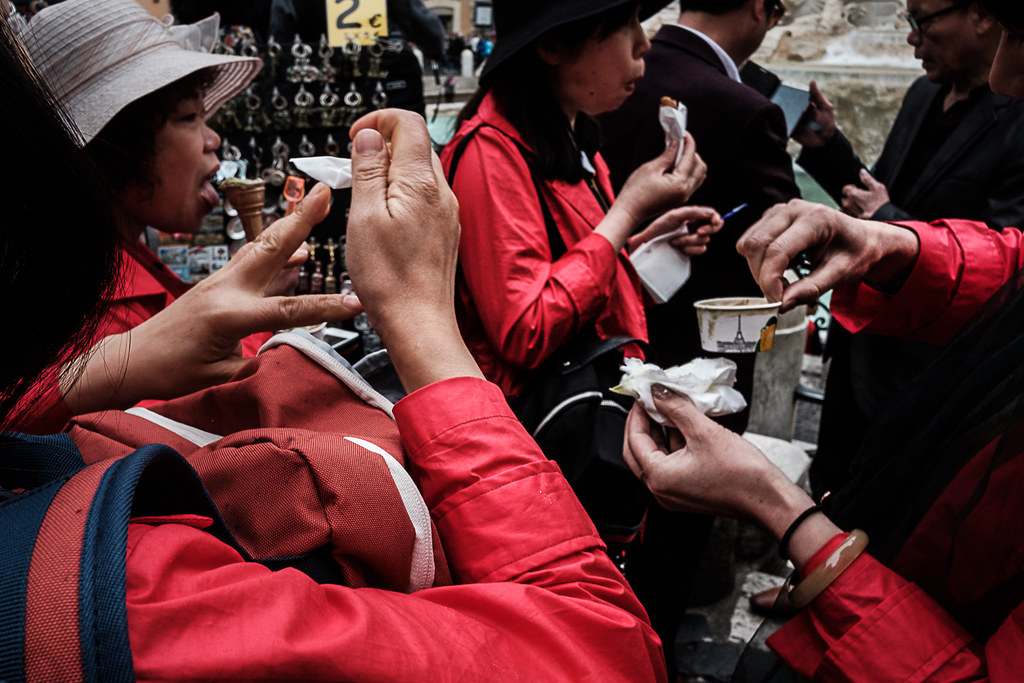





from Abbas Kiarostami: The Wind Will Carry Us
ReplyDelete